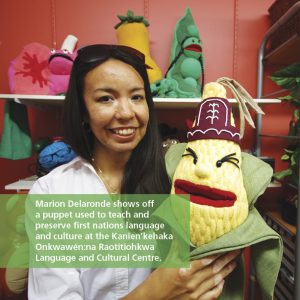‘Everything we are is in our language.’

 So says Callie Hill, a Tyendinaga First Nation member and executive director of Tsi Tyonnheht Onkwawenna Language and Cultural Centre in Quebec. Language describes our understanding of our place in the world and our relationship to the created order and to the creator, she adds.
So says Callie Hill, a Tyendinaga First Nation member and executive director of Tsi Tyonnheht Onkwawenna Language and Cultural Centre in Quebec. Language describes our understanding of our place in the world and our relationship to the created order and to the creator, she adds.
Losing language is one of the tragedies of First Nations first through colonization, and then with the residential school system. But a partnership between PWRDF and the Kanien’kehá:ka Onkwawén:na Raotitióhkwa Language and Cultural Center (KORLCC) aims to change that.
Based in Kahnawake, Que., KOR uses puppets to teach children the Mohawk language and culture. The puppets are effective at holding the children’s attention, says Marion Delaronde, the director of Tóta tánon Ohkwá:ri (the KORLCC puppet show).
Delaronde, a Mohawk, is also a filmmaker and hosts a TV series for kids. “Each episode focuses on something in the natural world … tells of our relationship with it. The children learn to give thanks for that thing,” she says. The episodes use mnemonics to teach culture and history, such as the 50 chiefs of the Iroquois confederacy, or one word in each of the five languages of the confederacy. Other episodes teach thankfulness and peacefulness using traditional legends like the Corn Husk Doll.
KOR’s language-revitalization program hopes to breathe life into the community’s cultural identity, by being one small light in the national cultural landscape. Canada was once home to more than 70 distinct First Nations languages, but now only a handful — such as Cree, Ojibway, Oji-Cree and Dene — remain strong and viable, according to Statistics Canada. Mohawk is one of those aboriginal tongues that is under threat of being lost, and KOR, with PWRDF’s financial help, is fighting to keep it alive.